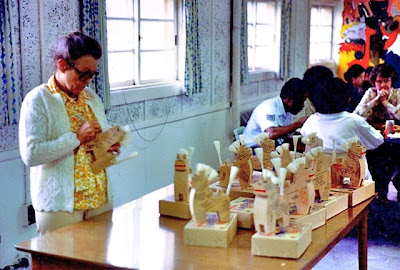Foreign Friday
Signing Hachinohe Horses was a custom in Misawa. After everyone had written their good wishes on the horses, they were presented to the students who were shipping out as a remembrance and a token of friendship.
The Hachinohe area of Japan has been known since the Kamakura period (1185 - 1333) for its breed of battle horses. Horses have played an important role in lives of those living in this area; thus, the art of Yawata-uma figurines, or carved and painted wooden horses become a regional art form.
The horses are consider one of the oldest and most recognizable toys in Japan. They are also known as Yawata Uma, which comes from their relationship with the activities at Hachiman shrines.
Traditionally the craftsman used only a hatchet and chisel to carve the wooden horses, then painstakingly painted them. The horses are still handcrafted and hand painted in a small factory in Hachinohe, Japan, which is close to Misawa.
Hachinohe horses come in many sizes, from less than an inch high to over a foot tall, although some larger statues are also made. The horses are sold singly or in pairs and usually painted black or red, with black denoting the male and red, the female. I have the three horses pictured above (the largest is about 8 inches tall) and two tiny ones that I put on my Christmas tree.
The unpainted horse was given to me by the small cast of the one-act play, Schubert's Last Serenade, which was presented at the Pacific Region Drama Festival.
The cast members signed on the sides, the bottom, and even the back of the horse.

The Hachinohe area of Japan has been known since the Kamakura period (1185 - 1333) for its breed of battle horses. Horses have played an important role in lives of those living in this area; thus, the art of Yawata-uma figurines, or carved and painted wooden horses become a regional art form.
The horses are consider one of the oldest and most recognizable toys in Japan. They are also known as Yawata Uma, which comes from their relationship with the activities at Hachiman shrines.
Traditionally the craftsman used only a hatchet and chisel to carve the wooden horses, then painstakingly painted them. The horses are still handcrafted and hand painted in a small factory in Hachinohe, Japan, which is close to Misawa.
Hachinohe horses come in many sizes, from less than an inch high to over a foot tall, although some larger statues are also made. The horses are sold singly or in pairs and usually painted black or red, with black denoting the male and red, the female. I have the three horses pictured above (the largest is about 8 inches tall) and two tiny ones that I put on my Christmas tree.
The unpainted horse was given to me by the small cast of the one-act play, Schubert's Last Serenade, which was presented at the Pacific Region Drama Festival.
The cast members signed on the sides, the bottom, and even the back of the horse.
Hachinohe horses will always remind me of my years in Misawa.






What a great post -- love the tradition of the horses and the colors... I could see a quilt made with those colors... thanks for sharing.
ReplyDeleteWhat a special keepsake..love that they signed it.
ReplyDeleteHow interesting!
ReplyDeleteI want one!!! They are too cute.
ReplyDeleteWhat a special remembrance of your time in Misawa.
ReplyDeleteWhat a treasure! They are also very artistic and beautiful designs. Having everyone sign them makes them extra-special. I love Foreign Fridays!!
ReplyDeleteWhat a lovely tradition! I love it when beauty, art and memories all collide...
ReplyDeleteI love horses, so this post was most interesting!
ReplyDeleteLived in Misawa as an adolescent in late 50s. Sweet and wonderful memories of Hachinohe. Then the craftsmen sat on the floor around small tables in a beautiful traditional building, dressed in traditional work clothes. I was merely a small guest but treated with a very tender kindness. My horses still sit on my shelf nearly 60 years later. Thank you for posting this. It is a wonderful memory. leslieah1900@yahoo.com
ReplyDelete